Reviews
Here Are the 11 Best Works of Art We Saw in 2019, as Chosen by the Artnet News Staff
Here's the very best of what we saw around the world.
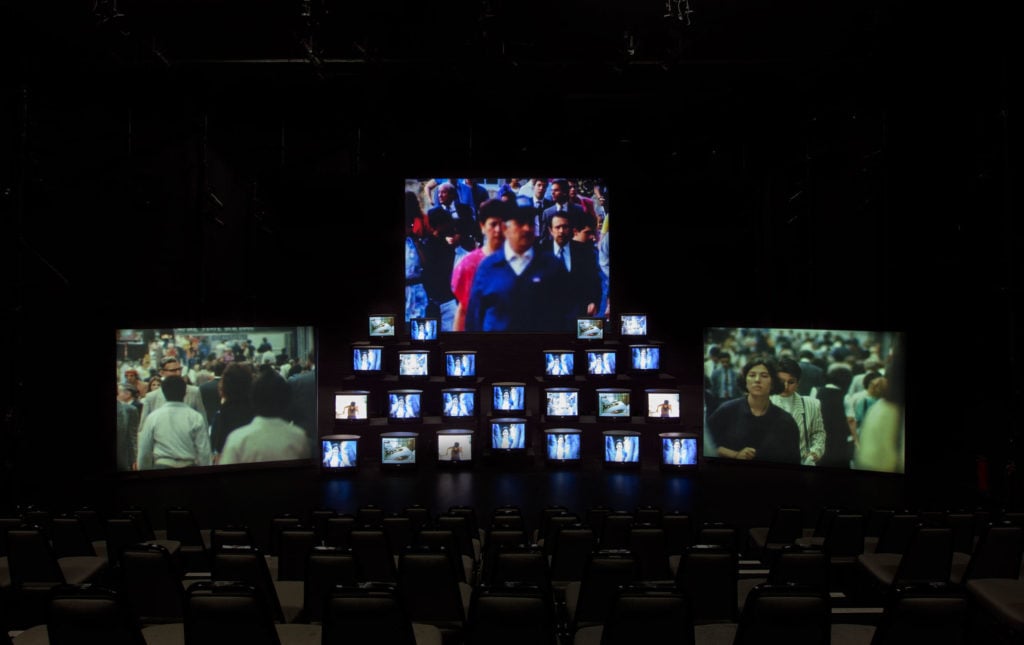
Here's the very best of what we saw around the world.

Artnet News

Sometimes you see a show or an artwork that you can’t forget. Below, our editors pick the most memorable, exciting, and enchanting examples they saw this past year.
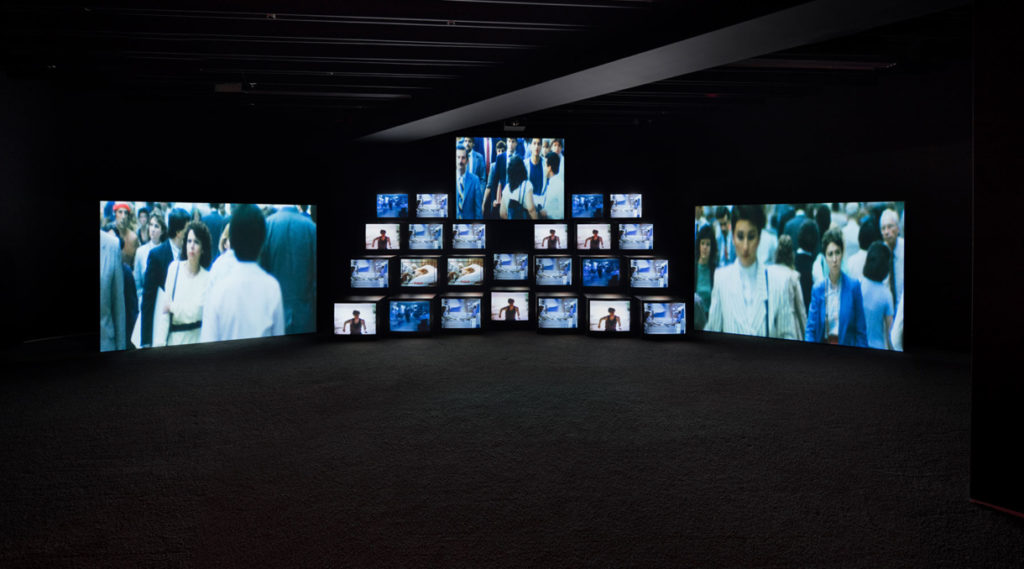
Gretchen Bender, Total Recall (1987) on view in “Gretchen Bender: So Much Deathless” at Red Bull Arts New York, 2019. Image © Gretchen Bender Estate.
Five years ago, I walked into a darkened gallery at a group show at the Hammer Museum in Los Angeles with no prior knowledge of Gretchen Bender. Total Recall lunged out of the black, grabbed me by the shoulders, and held me transfixed for the next 18 minutes. After I left the museum, I spent the rest of the day wandering around in an awed haze, trying to process what exactly I’d just experienced, and wondering whether I’d ever have another chance to engage with it in a more capable, sophisticated way.
“So Much Deathless,” Bender’s bravura retrospective at Red Bull Arts this year, gave the older, slightly wiser me a second shot. I’m thrilled to report it lived up to my memory. Propelled by a synth-driven original score that defines late-1980s menace, the work’s procession of images slam-dances across a stack of screens, transporting viewers into the mind of an unseen narrator trying (and failing) to chase away psychic pain with consumer goods, mass entertainment, and the hollow American dream of the Reagan era. It’s simultaneously troubling and seductive in the way that only the work of a true visionary can be.
—Tim Schneider
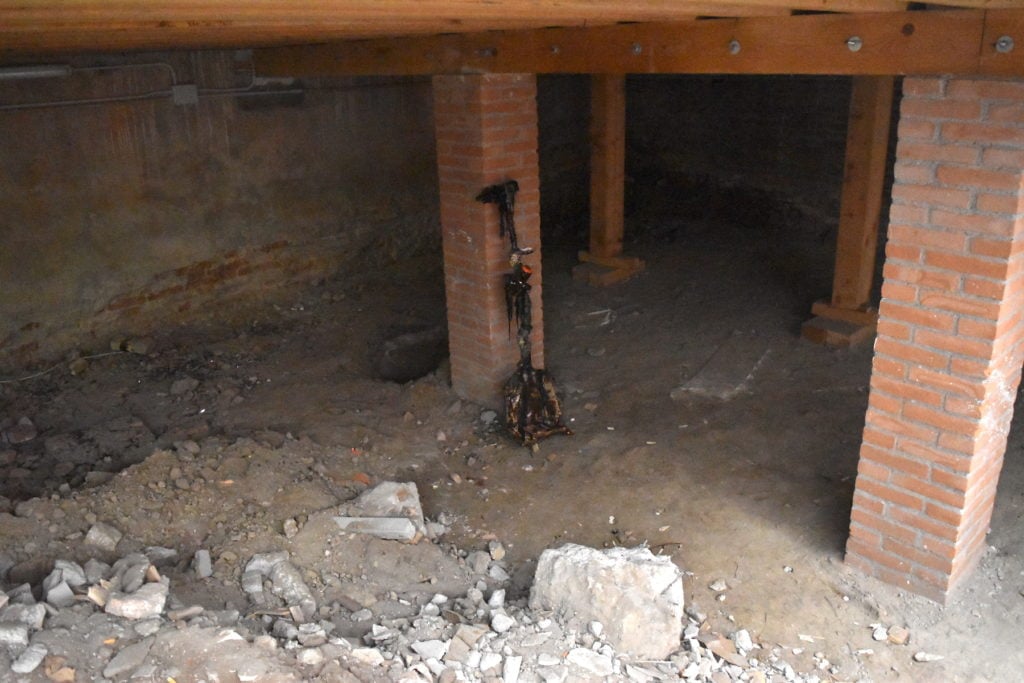
Laure Prouvost’s installation at the French Pavilion. Image courtesy Ben Davis.
There is a lot to say about Laure Prouvost’s brilliant Venice biennale presentation for France, a deeply layered installation for one of her films featuring delicate Murano glass absurdities, a squishy octopus’s belly, and boobs galore.
The film tracks a motley crew’s phantasmagoric road trip to Venice, an extraordinary journey that includes a visit to a shell-covered and dream-like (but very real) palace. But my favorite part was actually happening underneath the pavilion. Instead of having visitors enter through its grand entryway, Prouvost funneled them around the back of the pavilion and into the earth-filled basement, where she was in the middle of digging a hole across the Giardini to the British pavilion. Digging is a recurring theme in Prouvost’s work, a way of exploring below-surface ambiguities. Here she is: a Belgium-based artist (who spent enough time in the UK to win the Turner Prize) representing France in the kind of nationalist art-world Olympics that is the biennale. As a third-culture kid myself, I appreciated this gesture as a colossal middle finger (or tentacle) to Brexit, and a humorous collapsing of the walls and divisions that have sadly sprung up all around us. Taken altogether, it captures something of our liquid modernity.
—Naomi Rea

Lubaina Himid, Five Conversations (2019) in “En Plein Air” at the High Line. Photo by Eileen Kinsella
One of the reasons I loved this installation so much was because of how unexpected it was. Walking along the High Line on a beautiful autumn afternoon, I suddenly spotted the brilliant hues of these painted, standing doors peeking out from behind the elevated park’s lush greenery and overhanging leaves and I was immediately intrigued. The Tanzanian-born painter is known for her life-size portraits cut into silhouettes that stand freely as flat sculptures. In Five Conversations (2019), Himid introduced five reclaimed doors from Georgian townhouses painted with portraits of stylish women who converse with one another.
—Eileen Kinsella
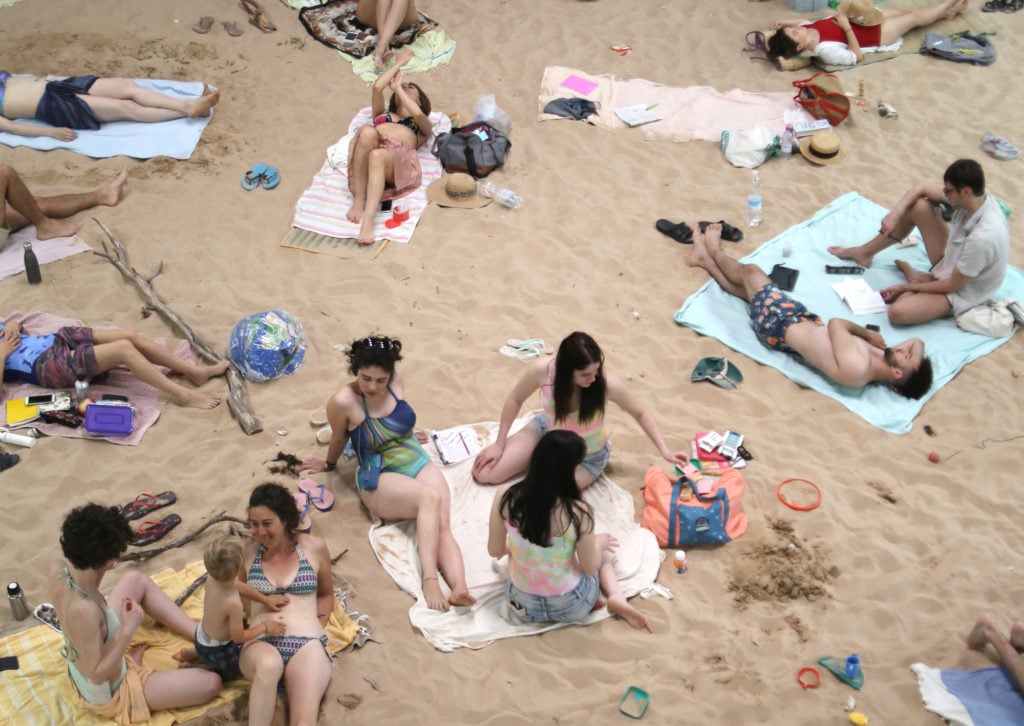
Lina Lapelytė, Vaiva Grainytė and Rugilė Barzdžiukaitė, Sun and Sea (Marina) (2019). Performance, Lithuanian Pavilion at the 58th Venice Biennial. Photo by Laima Stasiulionytė.
If this was the year that the art world—and the world at large—finally began to reckon viscerally with the reality of climate change, then I can think of no more enduring artwork from 2019 than Sun and Sea (Marina), the haunting opera and installation that won the Golden Lion at this year’s Venice Biennale. Organized by curator Lucia Pietroiusti, the Lithuanian Pavilion may seem like a gimmick at first: it’s a song-and-dance about climate change set at a beach. But it is actually one of the most understated and affecting artworks about climate change I’ve ever seen.
You watch it from a balcony, looking down at the familiar tableau of towels, beach chairs, and bright-colored bathing suits. (It’s hard to overstate the verisimilitude; dogs wander through, people listen to music on their iPhones—it’s all tonally just right.) As the performers sunbathe, they sing about their mundane vacations and minor annoyances. Slowly, it becomes clear that this sunny, sandy holiday masks real decay taking place offstage. Travelers tell stories of air travel interrupted by a volcanic eruption, a scuba-diving trip to the milky-white Great Barrier Reef, and a Christmas spent in springlike weather. Astoundingly, these scenarios seem considerably more likely now, just over six months after I saw the performance, than they did then.
The production is haunting because unlike most art about climate change, it doesn’t attempt to knock you out with the gravity of the problem. Instead, it chills you by presenting a world not so different from your own—one in which you sit idly in the sun while everything around you rots.
—Julia Halperin
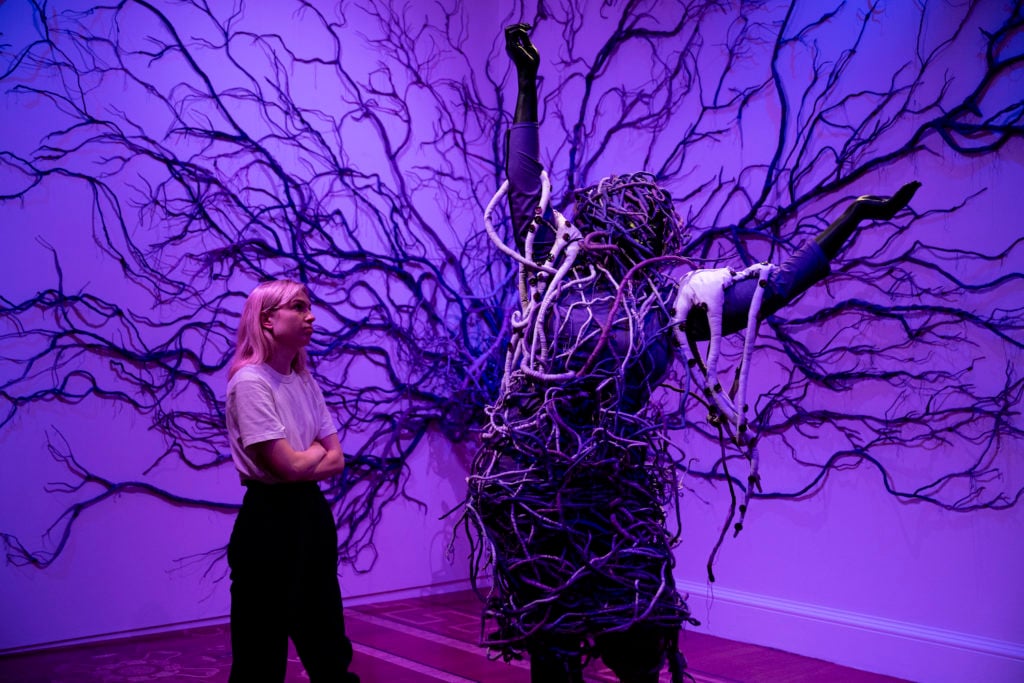
Mary Sibande’s A Reversed Retrogress, Scene 2 (2013) at Somerset House, London. Copyright the artist. © Anne Tetzlaff.
Every once in a while, an artwork takes your breath away. It sounds clichéd, but it happened to me back in 2013 at Pierre Huyghe’s show at the Centre Pompidou, when the pink-legged dog in the film I was watching grazed by my body. And it happened again just this fall at the Somerset House when I walked around South African artist Mary Sibande’s exhibition, “I Came Apart at the Seams.” In these moments, at least for me, I am left vulnerable and all my assumptions about the world crack apart.
Sibande is a singular artist brilliantly thinking through all the problems of voyeurism, especially when it comes to representing black experience and navigating narratives around post-colonialism. Her work deals with very difficult subject matter, addressing colonial history in South Africa, which she channels through a futuristic domestic worker named Sophie. Sophie is modeled after Sibande’s own body and is posed in vibrant traditional dresses, which are unravelled and reinterpreted in places as to revise and emancipate Sophie from the past. In A Reversed Retrogress, Scene 2 at Somerset House, Sophie is covered in papal purple tentacles that emanate out of her and up the wall as she stretchers her arms into the air. It seems like her body extends beyond her figure and reaches into the past and future simultaneously. The human scale of the work brings Sophie to life while also reminding viewers like me that we cannot ever truly begin to understand or know Sophie, whose face is hidden. It’s a deeply humbling work.
—Kate Brown
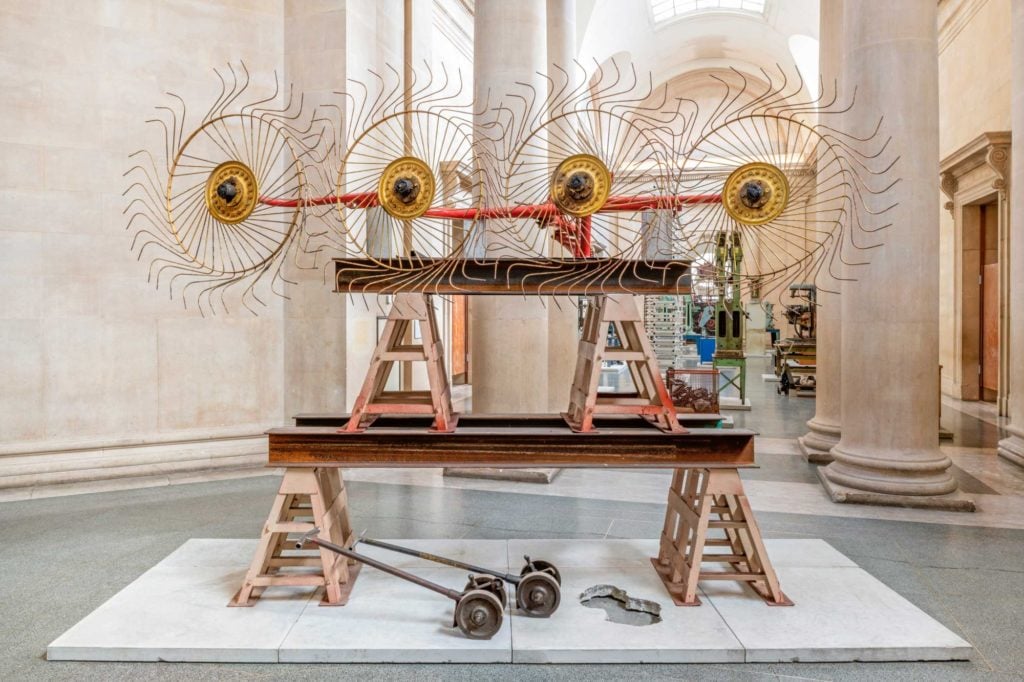
Mike Nelson’s The Asset Strippers (2019). Tate Photography, Matt Greenwood.
The British sculptor Mike Nelson is a one-man-band who orchestrates epic assemblages that hit you in the solar plexus, and linger in the memory. This spring, Nelson transformed Tate Britain’s neo-classical Duveen Galleries into a cross between a monument-strewn graveyard and petrified forest with the brutally titled The Assest Srippers. Old factory machinery, salvaged NHS hospital doors, telegraph poles, tarpaulins, and agricultural machinery, many sourced online from salvage auctions, became a melancholic monument to post-industrial Britain. Nelson’s Duchamp-meets-dystopia installation seemed topical from March through October as Britain teetered on the edge of crashing out of the European Union, its parliament in stalemate. After a tumultuous year, which ended in triumph for vote Leavers in the UK’s general election in December, Nelson’s work seems prophetic. The silent machinery belongs to a different age, frozen for an unforgettable moment and placed on a plinth before heading to the scrapyard of history.
—Javier Pes
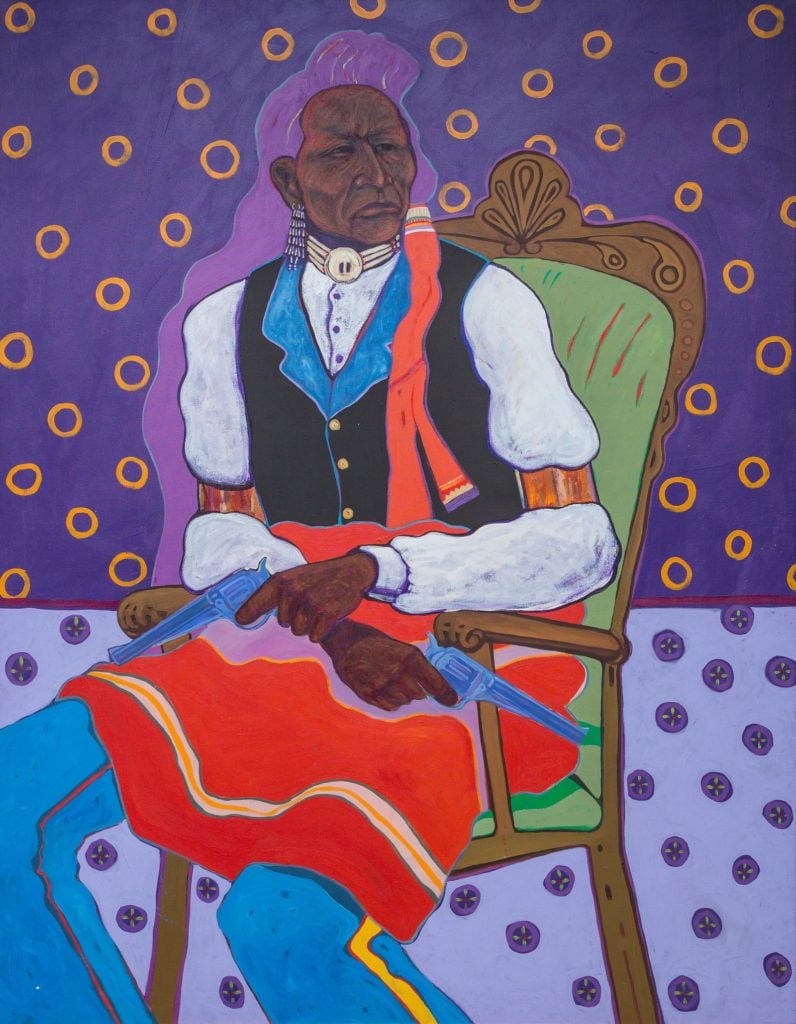
T.C. Cannon, Two Guns Arikara (1974–77), Courtesy of the National Museum of the American Indian.
When I popped into the National Museum of the American Indian on a rainy afternoon this summer I admit I knew next to nothing about the late T.C. Cannon, and this unexpected exhibition felt like the art-historical rug had been (thankfully) pulled out from under me. How exactly had I never heard of this guy? During the 1960s and ‘70s, the Caddo and Kiowa artist created dazzlingly colorful depictions of contemporaneous Native American life, melding his cultural heritage with political and cultural references from the Vietnam War (in which he fought) to fashion and music.
For me, Two Guns Arikara especially embodied Cannon’s virtuosity as he effortlessly brings together indigenous emblems, tropes of Western portraiture, and a dazzling Pop color palette. And it’s hard not to note that Cannon’s preference for patterned, colorful backgrounds prefigures so much of what we’re still seeing in figurative painting today. In the end, I find this portrait at once dignified, alive, and incredibly stylish. I love the slight, very 1970s flair of his pants, which quietly situate Two Guns Arikara in a specific American cultural moment.
—Katie White
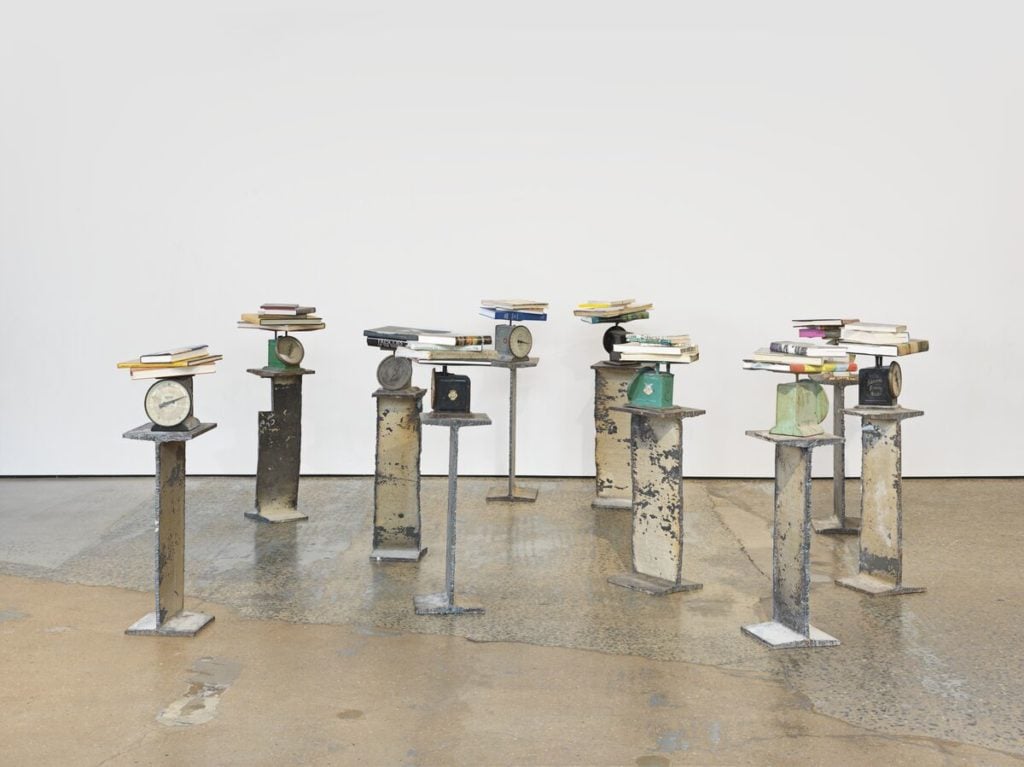
David Hammons, Untitled (2018). © David Hammons, photo: Genevieve Hanson, courtesy of Hauser & Wirth.
The David Hammons show at Hauser & Wirth Los Angeles—and it should be taken as an entire show, not just a group of individual works—was self-important and visually dazzling, full of grand universal beauty and insider-y easter eggs, complex installs and straight-up cheap tricks. God, I loved how infuriating it was, how contradictory, how rewarding after a long, long viewing. Dedicated to Ornette Coleman, the show knew no meter or key signature, and just flowed like the free jazz it was. Everything else seems boring now—and it was endlessly funny, to boot. And while there was an uproar over the tents, with some distance, it was brilliant that Hammons invaded the views of the Tinseltown influencers getting brunch at the gallery’s trendy Manuela restaurant with a reminder of how close they are to the shantytowns of Skid Row.
—Nate Freeman
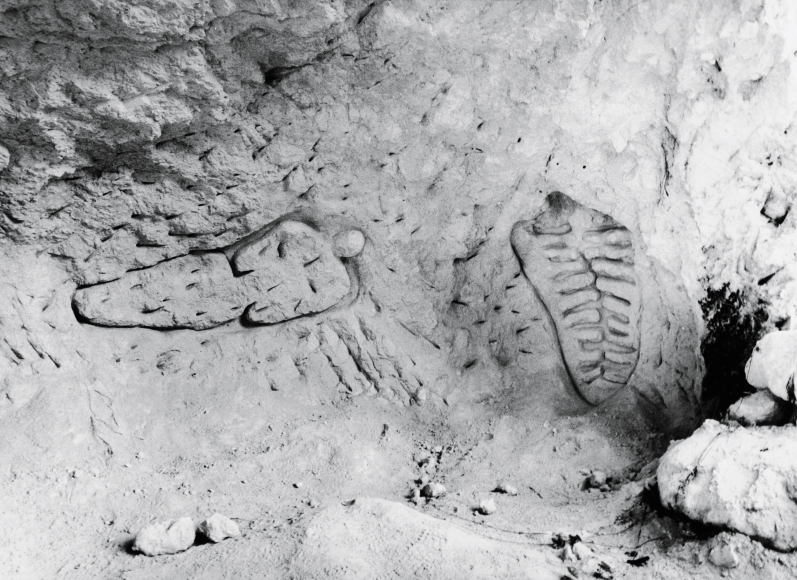
Ana Mendieta, Untitled (Esculturas Rupestres) (1981). Courtesy of Galerie Lelong.
Choosing the best art I saw in a year that involved visits to the National Gallery in Washington, DC, the Pushkin Museum in Moscow, and several trips to the Met presents the problem of an embarrassment of masterpieces. So I’m picking one of the best surprises I saw this year: Ana Mendieta’s carvings into Cuban caves, which she called her Rupestrian sculptures.
Mendieta, who fled the revolution in Cuba at age 12, returned to the island as an adult in 1981 and began to paint on and cut into rock. In some cases she left behind vague resemblances of a female silhouette, reminiscent of her earlier series of crime scene-style outlines of her own body on the ground. Others are forms taken from nature, such as leaves, and still others are pure abstractions. Her photographs of the sculptures, which were on view at Galerie Lelong this fall, revealed an exiled artist’s poignant attempt to make her “mark” on a landscape that wouldn’t have her.
—Rachel Corbett
Lisa Marie Reihana, a New Zealand artist of Maori descent, first showed her panoramic, multi-channel video work In Pursuit of Venus [Infected] at the Auckland Art Gallery in 2015, before representing the nation at the 2017 Venice Biennial. The riveting 64-minute film, which took over a decade to realize, recounts Captain James Cook’s encounters with native during his celebrated 1768–80 maritime voyages to the Pacific islands.
I was lucky enough to catch its U.S. debut this spring, at the Honolulu Museum of Art. (The work has since been acquired by the Fine Arts Museums of San Francisco de Young, where it is currently on view through January 5, 2020.)
Reihana shots 80 scenes inspired by Cook’s travels on green screens, and then overlaid them atop a scrolling background adapted from Les Sauvages de la Mer Pacifique, a 19th-century scenic wallpaper from French firm Joseph Dufour et Cie (part of the Honolulu Museum’s collection and also on view in the exhibition). But the film undermines the notion of Pacific islands as a utopian paradise, and rejects the prevailing colonial narrative, showcasing the fraught interactions between British explorers and natives, culminating in Cook’s violent death. The artwork is both a visual marvel of media art—the screen is 70 feet wide—and an important cultural critique that gives primacy to native voices.
—Sarah Cascone
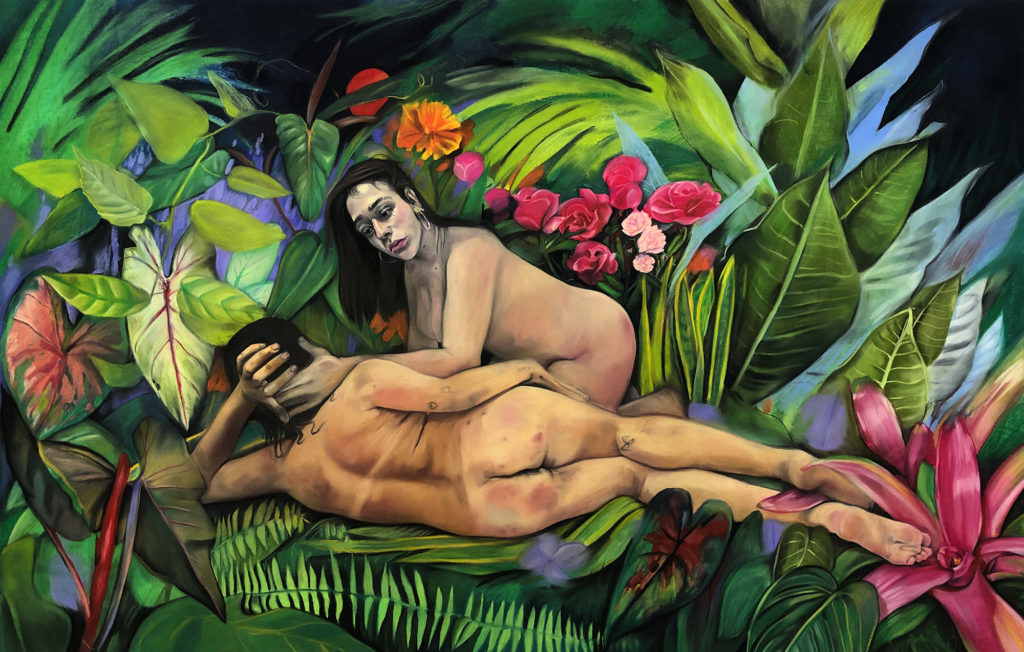
Alina Perez’s Seen Upon, In the Garden (2019).
I saw this work by Yale MFA candidate Alina Perez in February and I still think about it. At a whopping 50 by 75 inches, this fantastic yet realistic depiction of two lovers demands attention.
—Cristina Cruz